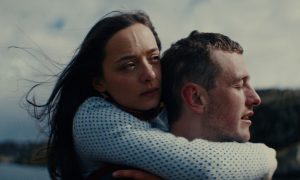Watching the ten films in the main European features competition of the Festival of European Cinema, held in the beautiful city of Lecce (Italy), I noticed a tendency ACROSS some of the selected films, quite widespread in this digital era we are in: an increasing hybridization of genres and styles, of not being ashamed to borrow AND MIX elements from so called mainstream cinema.
In the case of the film awarded the FIPRESCI prize, Copenhagen-does-not-exist/ Kǿbenhavn findes ikke (Denmark, 2022) by Martin Skobjerg, the members (Jason Best-Great Britain, myself and Tommaso Tocci -Italy) appreciated it to be the most advanced aesthetically, being, as the motivation states, “at the same time a challenging love story, a puzzling psychological drama and a gripping thriller, which challenges us with its fractured narrative and audacious editing but amply rewards our efforts.”

The first quality to highlight is the script, a very well written story signed by a name we previously appreciated when watching The Worst Person in the World / Warden verste menneske by Joachim Trier (2021) -Eskil Vogt, Oscar nominated for screenwriting along with the director.
The movie offers an original start to the narrative: a young man, Sander (Jonas Holt Schmidt) agrees to be locked in an empty apartment by two men, three months after the disappearance of his lover Ida (Angela Bundalovic), while being filmed and interrogated about their relationship. We discover the identity of the two men investigating the disappearance of the young woman, the girl`s father (the menacing Zlatko Buric, awarded the European Film Academy as best actor for his role in Triangle of sadness the previous year) and her brother (Wilmer Trier Brǿgger). Although intimidated by their inquisitive attitude, Sander does not offer clarifying answers about their decision to quit their jobs and to isolate themselves (in Copenhagen) some months before. We could accept his explanation about an intense love story and their need to escape “away from the madding crowd”, but still remain confused by the way he changes the details all the time. It’s obvious that there are contradictions in the retelling of the woman’s actions between the lover and the father. Maybe the most meaningful confounding is the one about the Ida`s limp foot, which Sander denies. As already noted, the lover is an unreliable narrator, which might be explained by his love and idealization of the disappeared girl. The mix of techniques and the suggestions of how the narrative of our lives is constructed could be well defined as “The truth comes in blows”, as in the title of Ted Solotaroff’s book.
The feature, with its stylish visual look, a very Scandinavian one, is also a typical meta-cinematic audiovisual content, an occasion to show off the cinematic tools (while we see the brother taping his sister’s partner confession, the action is reflected in the screen of a television set). With its master cinematography (signed by Jakob Mǿller), an excellent interpretation (mostly Angela Bundalovic, whose interpretation of the troubled Ida won her The Award for Best Actor, decided by the main jury in Lecce), a creative direction which builds a haunting atmosphere, compared by some critics to “a ghost story”, Copenhagen Does Not Exist is a movie to remember, fully deserving of a FIPRESCI award.
As mentioned in the beginning of my text, other hybrid films that combined tropes and elements of different genres were also part of the festival`s selection. For instance, the German Dead Girls Dancing by Anna Roller is, at the same time, a road movie about three friends on a trip to celebrate their graduation, which is at the same time a thriller with some spectacular car chases, and a horror story in which the teenage girls discover a ghost town and try to clarify the mystery of the inhabitants’ disappearance.
Another film illustrating the temptation to mix elements of different genres is the Polish Woman on the Roof/Kobieta na dachu by Anna Jadovska awarded by the main jury for the photography by Ita Zbroniec-Zait. It has a thriller premise in the story of an old woman who tries, unsuccessfully, to rob a bank, a story which switches to a family drama when the protagonist is confronted afterwards by her husband accusing her of tarnishing their honorable reputation. We notice how the film cultivates an ambiguity of the characters` motivations. THIS IS A trend we can also find in Remember to Blink/Per Arti, the feature crowned in Lecce for the script written by its Lithuanian director Austeja Urbaite. Last, but not least, the hybrid narrative and form is the formula of the Golden Olive Tree Award, the French film Midwives/ Les Sage-femmes by Léa Fehner, a mix of fiction and documentary, appreciated by the main jury as “a profound and personal examination of maternity, revealing secrets we rarely talk about.”
Dana Duma
Edited by Rita Di Santo
© FIPRESCI 2023
